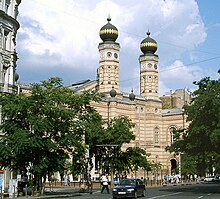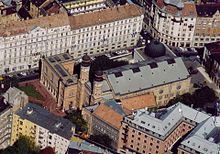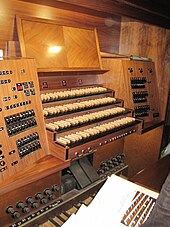Great Synagogue (Budapest)
The Great Synagogue ( Hungarian : nagy zsinagóga ) in Dohány utca , Tabakgasse in German , therefore also called Tobacco Temple , is a synagogue in Budapest built in the Moorish style for the Pest Jewish community according to plans by the Viennese architect Ludwig Förster 1854–59 . It followed the moderate rite, which in Hungary is called Neolog ( somewhat similar to Conservative Judaism ) and is now Europe's largest synagogue with 2964 seats.
history
In what was to become Budapest, Jews have been recorded for Buda since the 11th and for Pest since the 15th century. Jews were not allowed to settle in Pest again until the late 18th century. In the 19th century, the prosperous Jewish community in Pest recorded strong growth, so that the existing synagogues were no longer sufficient. Initially, the community could not agree on how orthodox the new synagogue should be, but in 1853 a compromise was reached and a competition was announced, which the Viennese architect Ludwig Förster won with a design in the Moorish style. Construction work began in the summer of 1854 and the synagogue was inaugurated on September 6, 1859.
The building complex also includes the Budapest Jewish Museum (Zsidó Múzeum), built on the site of the home of Theodor Herzl , the founder of modern political Zionism . The new building was erected for this purpose in 1930–1931 and contains pieces of the Pest Chewra Kadischa and now also commemorates the Holocaust . On the side wall of the synagogue is a memorial to the Swedish diplomat Raoul Wallenberg , who saved many Hungarian Jews during World War II .
description
The synagogue is similar to the Leopoldstadt synagogue in Tempelgasse planned by Förster in Vienna at the same time , but it is significantly larger. Both synagogues are kept in a “Moorish” style, which is mainly influenced by the Alhambra in Granada, but also by the Babylonian , Assyrian and Islamic architecture of Egypt and Turkey. It was also believed that the building was similar to the ancient Solomonic temple , especially the two towers lean against the two pillars Jachin and Boaz of the same. The supposedly oriental style, a kind of “Jewish Gothic ”, should therefore indicate an oriental origin of the Jews.
The facade of the synagogue is divided into three parts. The side projections are slightly protruding, the facade is emphasized by the two octagonal towers crowned by gilded small round domes, over 40 meters high. The outer walls are made of specially made bricks placed on a red stone foundation.
The interior, with the floor plan of a three-aisled basilica with an apse and double galleries, measures 37.93 × 24.65 meters and has around 3000 seats, half for women and half for men. Main and side aisles are separated by large round arches, the main aisle is divided by jagged arches and separated from the Torah shrine , which forms a separate structure on the east wall planned by Friedrich Feszl , on whose side wings the pipes of the organ rest. Franz Liszt and Camille Saint-Saëns , among others, played the organ .
organ
The large organ of the synagogue was built in 1996 by the organ building company Jehmlich . The main organ has 63 registers (slider chests) on four manuals and a pedal . Pipe material from the previous instrument was partially reused. From the fourth manual you can also play the Echowerk, which was built as a remote work with ten registers by the Hungarian organ building company BKM. The action actions of the main organ are mechanical, those of the echo mechanism and the stop action are electrical.
|
|
|
|
|
|||||||||||||||||||||||||||||||||||||||||||||||||||||||||||||||||||||||||||||||||||||||||||||||||||||||||||||||||||||||||||||||||||||||||||||||||||||||||||||||||||||||||||||||||||||||||||||||||||||||||||||||
- Pair : II / I, III / I, IV / I, IV / II, IV / III
- Secondary register: Zimbelstern (II), glockenspiel (IV, prepared)
See also
- Holocaust Documentation Center (Budapest) (Holokauszt Emlékközpont)
- Hungary in World War II / Shoa
- Kazinczy Street Synagogue (Budapest)
Memorial for Raoul Wallenberg
Individual evidence
- ^ Jeno Zsoldos, Randolph L. Braham : Budapest . In: Michael Berenbaum, Fred Skolnik (Ed.): Encyclopaedia Judaica . 2nd Edition. 4th volume. Macmillan Reference USA, Detroit 2007, pp. 244-249 ( online: Gale Virtual Reference Library ).
- ↑ a b c Carol Herselle Krinsky: Europe's synagogues. Architecture, history and meaning . Deutsche Verlags-Anstalt, Stuttgart 1988, ISBN 3-421-02933-4 , pp. 145-148 .
- ↑ a b c d Hannelore Künzl: Islamic style elements in synagogue construction of the 19th and early 20th centuries . Modified version of the habilitation thesis, Univ. Cologne, 1979. Lang, Frankfurt am Main et al. 1984, ISBN 3-8204-8034-X , p. 235-241 .
- ^ Synagogue Budapest / Hungary. In: Internet presence. Jehmlich Orgelbau Dresden GmbH, accessed on December 14, 2018 .
Web links
- Dohany street great synagogue Hidden treasures of Budapest
- Great Synagogue / Hungarian Jewish Museum Portal of memorial sites to places of remembrance in Europe
- Aerial photographs of the synagogue
- 360 ° photos of the interiors by Hans von Weissenfluh
Coordinates: 47 ° 29 ′ 45.2 ″ N , 19 ° 3 ′ 38.5 ″ E








